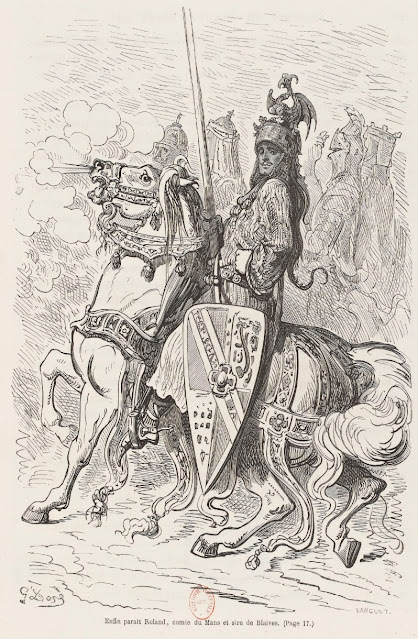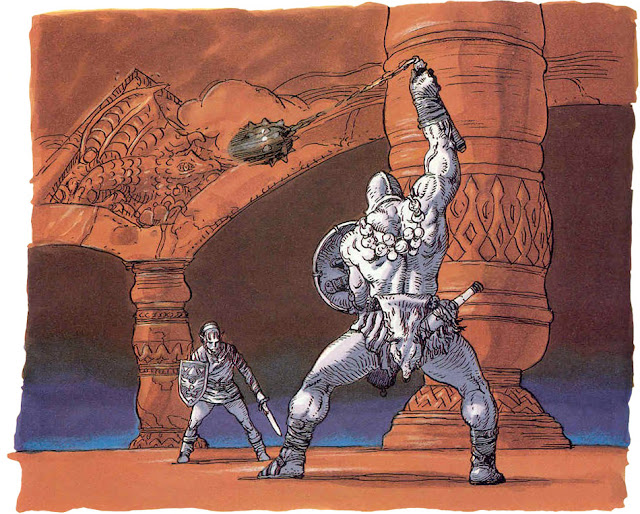 |
| Lang, F. (1924). Die Nibelungen. |
As I mentioned in my last post, my working approach for when close-up violence breaks out in my OD&D is probably best explained with examples. It varies a bit from what you usually see (at least what I've seen*) so let's talk about mêlée and other related concepts.
*Delving Deeper is pretty much the only clone I've seen that really dives into this level of "what if" when playing OD&D using a ton of bits from CHAINMAIL.
 |
| Dore, G. (1879). Orlando Furioso. |
Hell yeah! Fighting Capability!
Fighting Capability: This is a key to use in conjunction with the CHAINMAIL fantasyrule, as modified in various places herein. An alternative system will be givenlater for those who prefer a different method (Men & Magic p.18).
Key indeed! A figure's FC denotes the number of people that figure fights as in normal combat, followed by the fantastic-type the figure fights as in fantastic combat (if applicable). So-called "normal men" have no fantastic fighting ability.
In normal combat, multiple blows are struck. In fantastic combat, there is usually only one exchange of blows:
- Capabilities versus "normal men" are simply a matter of allowing one attack throw on the Attack Matrix I.: Men Attacking table for every "man" equivalent, e.g., a character with an FC of 3 Men would attack three times. Figures lacking an FC stat simply have one throw for every hit die unless noted otherwise, with any bonuses being given to only one of their attacks. So a Troll (6+3 HD) would attack "normal men" six times with one of the attacks having a +3 bonus.
- Capabilities versus "fantastic foes" are simply a matter of using the plain old "alternate combat" system that we always use for OD&D. Make your one attack throw unless noted otherwise and deal damage as normal.
"The following facts should be borne in mind for most creatures encountered in small groups. That is these represent "Hero" type monsters."
This type of "I know it when I see it" judgment works fine for me! The authors didn't use CHAINMAIL like this at all. Consider what Gygax had to say on this:
Any PCs are exempt from this even at first level: a "normal man" is ALWAYS 1 HD and cannot advance or gain levels. PCs are all "supernormal" since they can go up levels. Any monster of 1 HD or lower is treated as a "normal man" for purposes of this rule.
—Gary Gygax, 1973.
This approach basically carried over to the SR FAQ, Swords & Spells, and AD&D until it got transformed into cleave or something. Personally, I find the disconnect between 1 to 2 HD or classed figures here way too drastic. A 9th level fighter can contend with several 1 HD foes such as mercenaries or orcs in each round but a single 1 HD Magic-User demands all their attention? No thanks, bro.
Also, character-types gain more special abilities as they improve in level based on their Fighting Capability:
- Hero-1. Denotes that the figure can now participate in fantastic combat, albeit with a -1 attack throw adjustment.
- Hero (Anti-Hero): Denotes that the figure need never check morale and that the morale of any normal-types lead in combat by +1. Further, in normal combat, they are unaffected by fewer than 4 normal hits in a combat encounter.
- Superhero (Anti-Superhero): Denotes that opponents must check morale when approached or to approaching within 15". They can also detect invisible foes within 3".
- Wizard: Denotes that opponents must check morale when approached or approaching within 12".
- In CHAINMAIL, Wizards gain several special abilities, but it is in this writer's opinion that these are relegated to spells, e.g., seeing in darkness, throwing fire missiles, turning invisible, etc.
So for example, if a Hero was leading a couple of mercenaries and was throwing down with an Orge there are some tactical choices now at play. The Hero could protect their fellows by engaging in fantastic combat. The Ogre would then have to focus on the Hero or conduct normal combat with the mercenaries, but couldn't do both.
Striking a Foe
N.B.: Rounds are one minute long. An "attack roll" is not one swing, but is used to gauge your effectiveness over the course of the action. A "hit" may not necessarily mean a literal wound is inflicted or blood is even drawn. Melee distance is 10ft and is not static.
In the initial round of melee, the higher weapon class attempts the first blow.
A spearman (WC 8) fighting a swordsman (WC 4) would attack first.
In subsequent rounds, the lower weapon class attempts the first blow.
If the swordsman survived, they would now get the first attempt going forward.
Attacking from the rear, flank, or from above may override this and grant the first blow.
The swordsman fighting from a rampart would strike first, regardless.
Every blow has a counter-blow until figures exhaust their attacks.
A Hero (Lvl. 4 Fighter w/ Fighting Capability of 4 Men) is attacking a Warrior (Lvl. 2 Fighter w/ Fighting Capability of 2 Men). The order of striking would be Warrior, Hero, Warrior, Hero, Hero, Hero.
OR
The attacking figure strikes blows until they exhaust their attacks. Then counter-blows may be attempted.
A Hero is attacking a Warrior. The order of striking would be: Warrior, Warrior, Hero, Hero, Hero, Hero.
N.B.: I find that the alternative may be a bit much but it is in line with how many classic adventure games handle multiple attacks. Feels too one-sided at times and against the Chainmail blow/counter-blow spirit found in the Man-to-Man rules but YMMV. It's definitely easier to track in a larger melee!
Before an opponent strikes, a full parry can be attempted. This subtracts 4 from the attacker's throw, but the character parrying loses their next blow. If the attacker still makes their roll and gets exactly the number needed, the parrying weapon will be broken by a heavier weapon (or merely dashed away if the weapon is magical) and no damage inflicted. If, on the other hand, their opponent misses the defender is allowed a counter-blow if equipped with a lighter weapon.
The Hero deftly parries with the dagger and attacks the Warrior with a riposte!
Before damage is rolled, a shield may be sacrificed to negate a single strike. This only works for conventional attacks--other, specific types of shields might stop magical attacks.
Having been hit with a terrible blow by an Ogre, the Hero's shield is splintered but they are unharmed this round.
So basically some rather minor additions that can spice things up and get folks thinking. But what else?
 |
| Dore, G (1886). The Legend of Croquemitaine. |
Length, Weight, and Weapon Uses
So we are accounting for weight with parrying and length when it comes to gaining the first strike. That already makes choice rather important in a game where HP is low. What I do next is toss in some weapon uses (100% stolen from Luke Gearing's OD&D and Wolves Upon The Coast btw). I find these rather more intuitive for folks than giving them an array of weapon piercing capabilities or an entry from the M2M table in Chainmail. It gets them thinking about actionable tactics before they even mark off the gold to buy a weapon.
1d6 with dis/advantage b/c it's cool and easy and gives choice without as many "correct" answers
weapons powers ditto
— Luke Gearing on the bird site
A player's reaction once someone tears their shield away with an axe or ruins their plate suit with a mace is usually wanting to try it out themselves. Working as intended.
As pointed out by Luke, these "weapon uses" are just a place to start. Everyone at the table should look beyond them. The goal is to get you thinking about combat as a puzzle and not just taking a spear for reach and a mace for armor busting and calling it a day. I just want to constantly remind players to try solutions and attempt things in combat the same way they deal with less violent problems or puzzles.
So the classic CHAINMAIL weapons through this lens are:
- Dagger (1). Throw-able. Usable in a grapple situation.
- Hand-Axe (2). Throw-able. If 4+ damage is dealt, the hand-axe bounces, ‘attacking’ again.
- Mace (3). Increases AC of those struck by 1 to a maximum of 7. This effect is permanent.
- Sword (4). Riposte** once.
- Battle-Axe (5). May sacrifice 3 damage from an attack to attempt a weapon/shield strip. Roll a second attack - if successful, a weapon or shield can be ripped from the grip of the opponent.
- Morn. Star (6).* Those struck are thrown backward if unable to make a Paralysis Save. Use the damage rolled to determine distance, minus the HD of the creature struck.
- Flail* (7). Ignores shields.
- Spear (8). Throw-able. Can be "set" to receive a charge, dealing double or even treble if the force is sufficient.
- Polearm (9).* There are a broad variety of polearms. Some excel in formation-fighting, others are great hacking weapons. Pick either:
- Grant a nominated adjacent ally a -2 to incoming attacks.
- If a 6 is rolled for damage, roll another d6 and add the result. This effect can be triggered multiple times. Those targeting the wielder are at a +1 to-hit.
- Poleaxe (9).* AC of the target is treated as 7 when attacked.
- 2-hnd. Sword (10).* Upon a killing blow, the wielder can roll another attack. This effect can be triggered multiple times.
- Mnt. Lance (11). Inflicts double damage on the charge.
- Pike (12).* Can fight in multiple ranks.
**Riposte: Attacks against the wielder which score below 7 result in the wielder being able to attempt a counter-attack, resolved normally.
I think this avoids the issues with weapon capabilities that I outlined before and largely accomplishes my goals. It's a setup that rewards choice and experimentation as well as tables working together to actually think about how they use their weapons. Good deal!
That said, I have been tempted by the novelty of table lookups lately...
 |
| Dore, G. (1886). The Legend of Croquemitaine. |

























